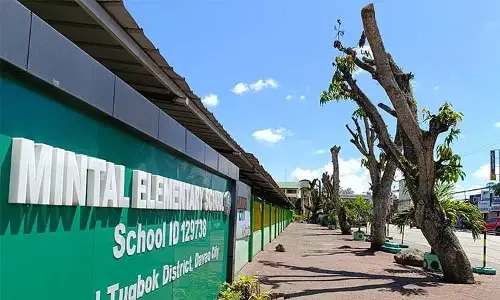
MINTAL Elementary School emphasized that the topping of trees within and around its campus was solely for the safety of the students.
Oliver P. Inis, head teacher of Mintal Elementary School, said in a media interview, on Friday morning, October 18, 2024, that they had applied for a permit to prune the trees due to instances where dead branches had fallen, posing a threat to student safety.
“Ang right to life mao man gyud ang pinakataas nga dapat maprotektahan nato, ang mga right sa mga bata, right to life so mabagsakan dili nato makuan (The right to life is the highest right that we should protect for children. If an accident occurs, such as children being struck by a falling branch, it endangers them),” he said.
Although there have been cases of branches and trees falling, Inis stressed that, thankfully, there have been no reported injuries among children or school staff due to these incidents. Thus, he reiterated the need to prune the trees arose because of those incidents to prevent future accidents.
Inis noted that one of the trees at the far end of the school is already rotten from the inside and poses a significant threat not only to students but also to pedestrians. He explained that pruning the tree would mitigate potential damage if it were to fall, as the branches would have already been removed.
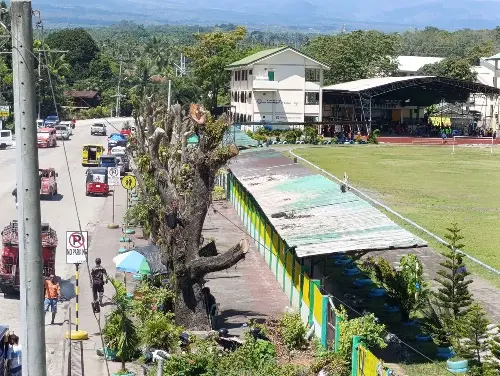
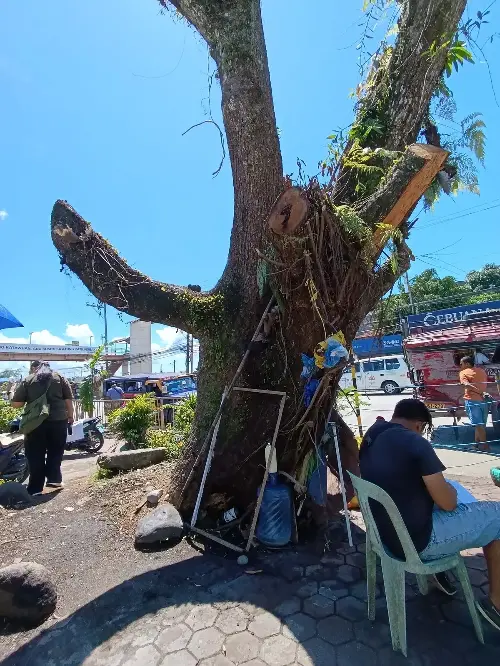
Inis added that before the trees were pruned, students and staff were afraid to walk near them as the possibility of branches falling during heavy rain and strong winds is high.
He added that the school did not determine the extent of the pruning as it was recommended only by the City Environment and Natural Resources Office (Cenro). The school emphasized that pruning would not kill the trees, citing that new leaves have already begun to sprout from the branches.
Inis also noted that the last pruning occurred about two years ago, and they sought assistance from Cenro, as the school lacked the means to prune the trees themselves.
Inis stated that the pruning of the 18 trees took more than three weeks: Cenro took three days, followed by the Department of Public Works and Highways (DPWH), which worked for about two weeks to prune the trees and clear the area.

Legally pruned
Inis reiterated that the school underwent the proper processes and obtained the necessary documents for the tree pruning. They even posted the permit outside the school.
The school holds a DENR Permit to Prune/Trim No. DENRXI-DC-0802-2024-021, which states that the pruning was requested for safety and security reasons. The document specifies that they would prune eight mango trees, two mahogany trees, three talisay trees, one tangisang bayawak, and four molave trees. The pruning permit is valid from August 2 to September 22, 2024.

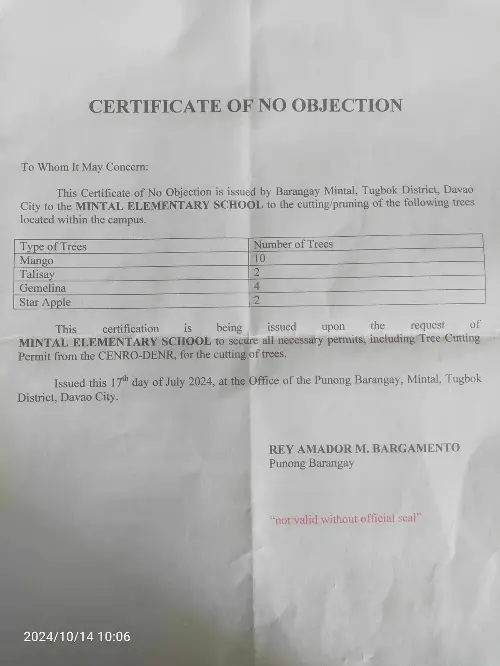
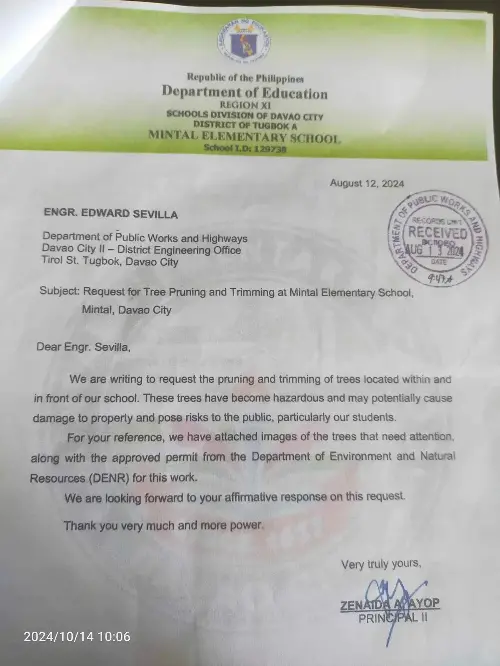
“That the permittee shall observe proper cutting practices to avoid untoward incidents including proper disposition of the trees and parts thereof inconsistent with Republic Act 9003 otherwise known as the Ecological Solid Waste Management Act,” the document.
Additionally, the school has obtained a certificate of no objection issued by Barangay Mintal, Tugbok District, for the pruning of trees located within the campus. This certification was issued on July 17, 2024, to secure all necessary permits for the pruning.
In a letter addressed to DPWH on August 12, 2024, Zenaida Ayop, principal of Mintal Elementary School, stated that the trees within and outside the school “have become hazardous and may pose risks to the public, particularly our students.” Therefore, they are requesting the pruning and trimming of the trees.
Rising temperatures due to severe pruning
Meanwhile, Davao City-based environmental group Interfacing Development Interventions for Sustainability (Idis) reported that based on their studies, the temperature outside the school increased to 45 degrees Celsius after the trees were pruned.
Justin Joshua Pungyan, environmental research officer of Idis, said during the Kapehan sa Dabaw, on Monday, October 14, 2024, at SM City Davao, that the temperature outside the school is 15 degrees higher compared to an area near the school with a natural canopy of trees.
“Dako kaayo ug deperensya sa kainiton ug dako kani nga epekto sa mga communities ilabi na sa katong nagagamit didto nga space before, ilabi na sa mga bata nga nagagawas sa eskwelahan, sa mga parents na nagahulat didto sa eskwelahan,” he said.
(There is a huge difference in temperature, which has a significant effect on the communities, especially for those who used that space before, particularly the children who exit the school and the parents waiting outside).
Earlier, Reynante Solitario from the Department of Education (DepEd)-Davao City Division explained that the school sought permits from the necessary offices and is constructing a perimeter fence, as the trees had already damaged school facilities. Additionally, the school aims to improve pathways to prevent students from getting wet during heavy rain.
Green spaces for schools
Idis is encouraging the principals and supervisors of schools in Davao City to retain the green and natural spaces in their schools because multiple studies reveal that having a green environment improves the learning capabilities of students. In addition to better learning space, the students would have access to better air quality and cooler surroundings due to the shade that the trees provide.
Camilo Victoria, forester of Idis, said that site development plans of schools should include green spaces. This is to ensure that when a new building is constructed there will be no trees that would be cut in order to make way for the construction.
“Sa site development plan sa isa ka eskwelahan dapat i-include na daan ang greening dili lang puro building. Naa man gali development plan na building but then nakabutang na didtoa daan asa itanom ang mga kahoy (In the site development plan of the school, the greening area should be included not only the building, it should have a space where the trees would be planted so in case there is development no trees would be harmed),” he said.
Meanwhile, for urban schools that are already congested, Victoria suggested that schools could use drums and plant medium-sized trees so that greenery is still available within their campus.
Call to action
Lemuel Manalo, program coordinator of Idis, called for coordination among government agencies regarding tree-cutting and pruning techniques in the city. He stressed that there have been multiple issues, especially since the Implementing Rules and Regulations (IRR) of the Heritage Trees Ordinance have yet to be crafted. He suggested prohibiting tree topping as a pruning technique in the ordinance.
“We are calling for the Community ENRO na[that] as much as possible different types of cases kailangan gyud na ang [there should be] approval also, any measure of approval or checking coming from the local government unit and endorsement,” he said.
Manalo noted that multiple local legislations protect trees in Davao City, but these are limited to trees located in critical watersheds. Trees in urban areas remain vulnerable because only Cenro oversees them.
He suggested that permits issued by Cenro should indicate the percentage of the trees to be pruned and the removal of selective branches that pose a threat. He also emphasized that DPWH should strictly adhere to the guidelines for cutting or pruning, which only allows two methods: crown raising and crown thinning.
The group is urging Davao City Mayor Sebastian “Baste” Duterte to release an executive order, as the Davao City LGU has the capacity to address cases of severe pruning by contractors and companies responsible for tree maintenance.
To recall, Idis raised concerns over the pruning of trees in Mintal elementary school, arguing that what occurred was not proper pruning but rather tree topping, which decreases the trees' chances of survival. Although the group acknowledged the school’s concerns for student safety, they consider the pruning conducted by DPWH as the worst type of pruning.
Idis revealed that the method used by DPWH was tree topping, an arboricultural practice involving severe cutting of a tree’s crown and the removal of its main branches. Foresters and arborists consider this method improper and harmful. Various studies indicate that tree topping has severe negative impacts on trees and the environment, making them more susceptible to pests and diseases. RGP
